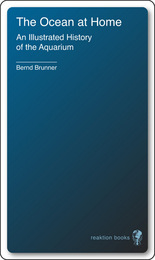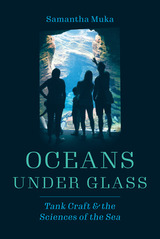
The mysterious world beneath the ocean’s surface and its inhabitants have captivated humanity for centuries—the Egyptians, Greeks, Romans, and ancient Chinese all kept fish in their homes to observe and admire. But it was not until the nineteenth-century invention of the aquarium that the deep was truly domesticated, offering the curious a chance to create an indoor exotic sea world, in miniature.
In The Ocean at Home, Bernd Brunner traces the development of the aquarium from the Victorian era to the present day. Along the way, in this fascinating history, Brunner provides insight into the cultural and social circumstances that accompanied the aquarium’s swift rise in popularity. Brunner tells a compelling story of obsession, discovery, and delight—from the aquarium’s origin as a tool for scientific observation to the Victorian era’s elaborately decorated containers of curiosity, to the great public aquariums that are popular in cities around the world today.
Featuring more than 100 illustrations, this updated edition of The Ocean at Home offers a colorful and captivating look at how a Victorian obsession still enchants many today. Both the owner of a humble goldfish bowl and the dazzled spectator at major public aquariums will find The Ocean at Home an appealing and knowledgable guide to the aquatic worlds we create.

Atlantic coral is rapidly disappearing in the wild. To save the species, they will have to be reproduced quickly in captivity, and so for the last decade conservationists have been at work trying to preserve their lingering numbers and figure out how to rebuild once-thriving coral reefs from a few survivors. Captive environments, built in dedicated aquariums, offer some hope for these corals. This book examines these specialized tanks, charting the development of tank craft throughout the twentieth century to better understand how aquarium modeling has enhanced our knowledge of the marine environment.
Aquariums are essential to the way we understand the ocean. Used to investigate an array of scientific questions, from animal behavior to cancer research and climate change, they are a crucial factor in the fight to mitigate the climate disaster already threatening our seas. To understand the historical development of this scientific tool and the groups that have contributed to our knowledge about the ocean, Samantha Muka takes up specialty systems—including photographic aquariums, kriesel tanks (for jellyfish), and hatching systems—to examine the creation of ocean simulations and their effect on our interactions with underwater life. Lively and engaging, Oceans under Glass offers a fresh history about how the aquarium has been used in modern marine biology and how integral it is to knowing the marine world.

Parlor Ponds: The Cultural Work of the American Home Aquarium, 1850–1970 examines the myriad cultural meanings of the American home aquarium during the nineteenth and twentieth centuries and argues that the home aquarium provided its enthusiasts with a potent tool for managing the challenges of historical change, from urbanization to globalization. The tank could be a window to an alien world, a theater for domestic melodrama, or a vehicle in a fantastical undersea journey. Its residents were seen as inscrutable and wholly disposable “its,” as deeply loved and charismatic individuals, and as alter egos by aquarists themselves.
Parlor Ponds fills a gap in the growing field of animal studies by showing that the tank is an emblematic product of modernity, one using elements of exploration, technology, science, and a commitment to rigorous observation to contain anxieties spawned by industrialization, urbanization, changing gender roles, and imperial entanglements. Judith Hamera engages advertisements, images, memoirs, public aquarium programs, and enthusiast publications to show how the history of the aquarium illuminates complex cultural attitudes toward nature and domestication, science and religion, gender and alterity, and national conquest and environmental stewardship with an emphasis on the ways it illuminates American public discourse on colonial and postcolonial expansion.
READERS
Browse our collection.
PUBLISHERS
See BiblioVault's publisher services.
STUDENT SERVICES
Files for college accessibility offices.
UChicago Accessibility Resources
home | accessibility | search | about | contact us
BiblioVault ® 2001 - 2024
The University of Chicago Press









